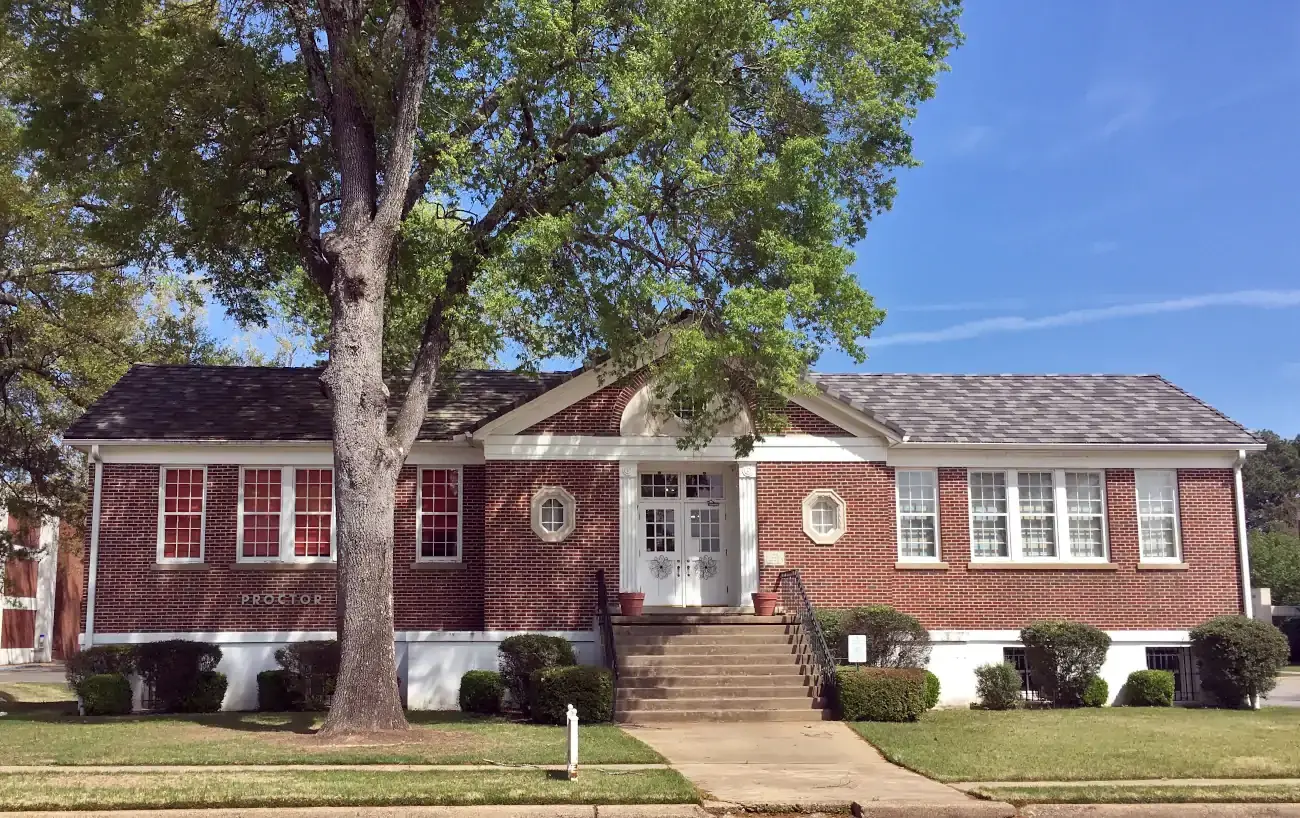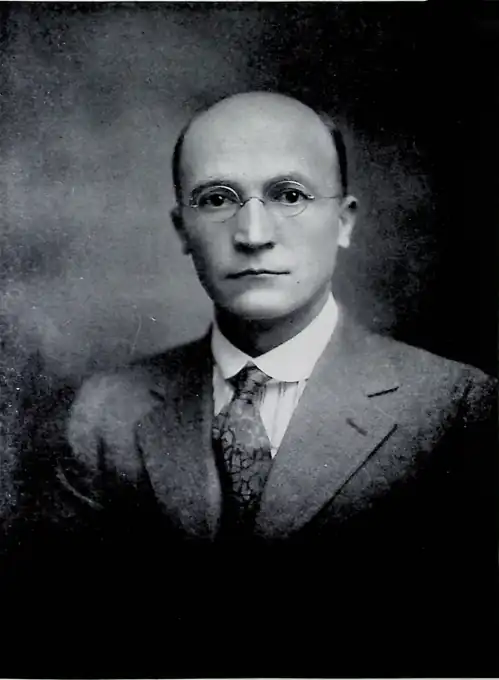Proctor Hall

Namesake
Dates
- Built: 1938
- Named: 5/23/1938
Map
History
In its fourth step for the acquisition of buildings [from 1905-1915], to erect an Alumni Hall, the College was not so fortunate as in its previous additions. The Class of 1906 had initiated an Alumni Hall Fund by contributing $100 as their gift to the College. In 1908, the Alumni Association invited former students to contribute from $5 to $50 for the erection of an Alumni Hall; the Association hoped to lay the foundation by the summer of 1909. However, in the spring of 1909, the Athletic Association proposed the building of a gymnasium. With limited resources available for financing both an Alumni Hall and a gymnasium, the Alumni and the Athletic Associations joined forces for a combination building to be used by both groups.
The two Associations had plans drawn for a magnificent three-story building of concrete and pressed brick, with a slate roof. The basement, or ground floor covering the entire space, would have “lockers, baths, etc., for the boys,” and provide storage for “all athletic paraphernalia.” The second floor would have a large hall for the Y.M.C.A. and a room for trophies where committees and small gatherings could convene. The rear part of this floor would contain the gymnasium, large and commodious, which could also be used for all Alumni Banquets. The third floor would have two halls for the Gamma Sigma and Garland Literary Societies; over the gymnasium would be an open amphitheater, “with running track and a place where audiences could witness games”.
This project, too, demanded money. The two Associations collected about $1,800 in cash and subscriptions when they began a drive in 1908-09. At the Little Rock Annual Conference held in Arkadelphia on November 24-29, 1909, a subscription of about $1,200 for Henderson College was taken, contributed mostly by former student classes, and teachers of the College. The Board of Trustees turned the amount over to the Alumni Building Fund to make the total a little over $3,000 in that Fund.
For a building site, the College purchased Block 30 in Hardy and Barkman's Addition from W. E. and Florence R. Barkman for $1,150. Facing what is now Henderson Street, the site joined the eastern border of the front campus.
On March 29, 1910, after stakes had been driven and the lines drawn, the Associations sponsored a ground-breaking ceremony for the building to cost $15,000. President Hinemon, James R. Haygood, Rev. T. D. Scott, Rev. J. C. Rhodes, Rev. W. F. Evans, J. B. Evans, and “Joe Finter (colored) took part in the ground-breaking ceremonies.” Each turned “a few shovels of mother earth in demonstration of their faith in the plans”.
However, before completing the Hall, the Associations would need to secure at least $12,000 more in subscriptions. By May 10, workers had completed the excavation and started the foundation. In January, 1913, the College again planned to complete the Alumni Building and invited all to come to join in the work. “You may bring a team and haul sand and gravel. You may give in cash or a note. You may donate farm land, timber land, raw land, town lots—anything (but help!)”.By 1915, the Alumni and Athletic Associations had accomplished all that was ever done during the Methodist years: They had laid the foundation, with faculty, students, and other volunteers performing the labor.
By 1928, the Alumni Building foundation, long an eyesore, had undergone some changes on the inside. On the east side, the College had constructed storerooms for football equipment, men's dressing rooms, and showers; on the west side, accommodations for a new pressing shop, with new machinery installed. Elroy Hagan and Lyle Brown, students, ran the pressing shop. With these temporary adjustments to the old foundation, no longer would students refer to it as the weed patch.
Ever since coming to Henderson, President Womack had dreamed of "one more piece of construction work that is sadly needed on the campus, namely, the completion of the building begun some years ago”. Of course, he referred to the foundation for the Alumni Building on the lot next to the President's home. Through the years, the old foundation had been a blemish on the campus. Every summer it enclosed a weed patch which added nothing to the attractiveness of the grounds.
During the years after 1929, Henderson had partitioned the historic Foundation, now referred to as “The Annex," at various times for a maintenance shop, a Men's Club Room, two classrooms, a nursery school, and a temporary house for the football team until Haygood Gymnasium was completed in 1935 and the new Field House in 1937.
To President Womack, The Annex still needed to be completed in more acceptable fashion. As a result of his diligent efforts, Mr. Womack was finally able in 1935-36 to get the W.P.A. to approve a project to build eight classrooms on the old Foundation. But, in May, 1936, “There was no prospect of its doing so since skilled labor for the work cannot be had.” Yet, Mr. Womack commented, “The building needed to be completed for the sake of the appearance of the campus and because the College needed the classrooms”.
At last, on May 31, 1937, President Womack reported to the Trustees that the W.P.A. had approved the construction of six classrooms on the old but sound Foundation, if Womack would furnish $5,600 of the funds. On motion by Dr. Sam Thompson, seconded by J. Oscar Humphrey, the Board agreed “to borrow $5,600, or as much as may be necessary to complete the W.P.A. project from J. P. Womack at 4% interest”. A year later, the building was completed in the same architectural style, red brick and white stone trim as the other new buildings on campus. It contained eight rooms and two offices as originally planned. The ground floor was occupied by the Reserve Officers Training Corps; and the upper floor was used as classrooms.
The College named the new classroom building Proctor Hall in honor of Robert Thomas Proctor, teacher, and later registrar, with 31 years of service to the school; with “students, other faculty men, and general laborers”, Mr. Proctor had helped to construct the original foundation in 1910-11.
Proctor Hall was formally dedicated on May 23, 1938, during Commencement Week. Speakers for the occasion included President H. Vance Posey of Southeastern State Teachers College, Durant, Oklahoma, and member of the Class of 1914, representing the students of Henderson-Brown; James H. Pilkinton, of Washington, Arkansas, Class of 1936, the alumni of Henderson State Teachers College; and John Baker Elms, Class of 1938, the present students. Fletcher McElhannon spoke briefly on behalf of the Board of Trustees; and R. T. Proctor responded in a brief talk.
President Womack had at last seen his dream come true in the completed classroom building known as Proctor Hall. He had brief time to enjoy seeing the handsome structure next to the President's home, for the next day after the dedication the Trustees fired him.
At a Board meeting on May 31, 1937, President Womack had reported to the Board that in negotiating with the Works Progress Administration for the construction of Proctor Hall, the W.P.A. wanted the College to agree to furnish $5,600 of the cost, and he offered to lend the sum to Henderson. The Board then voted “to borrow $5,600, or as much as may be necessary to complete the W.P.A. project, from J. P. Womack at 4% interest.” By a vote of 4-1, the Trustees then amended the motion to include $2,150 in the loan for the purchase of another plot of land now held by J.P. Womack and his wife for the College”. At the time, all Trustees and the President seemed satisfied with the agreement.
However, in a turn of events, in a Warranty Deed dated June 1937, the Womacks, for the sum of $1.00, conveyed to the Board of Trustees the parcels of land for which President Womack had paid $2,100 “in consideration of the love and interest which they have for said institution, and the further condition that said College pay them or either of them four per cent per annum on the value of said lands so long as they, or either of them, may live.” The interest of $88.00 was first due on March 23, 1938, and annually thereafter.
The next year, when the Board ousted Womack as President on May 24, 1938, the Trustees authorized the business manager “to pay interest to Mr. Womack under the contract”; they also voted to “make arrangements to repay all money due Mr. Womack”. For reasons not recorded, the Board voted on January 21, 1941, “to defer action on the payment of interest to Mr. J. P. Womack on loans made by him to the College.” At their meeting on April 18, 1941, after the reading of a letter from Lyle Brown, attorney, “relating to a deed and payment for certain land and a memorandum relating to interest payments to Mr. J. P. Womack,” E. K. Edwards moved that a committee of three be appointed to negotiate with Mr. Womack “to effect a settlement of both matters and to get a clear title to the land.” The Board passed the motion unanimously. Chairman R. B. Moore appointed J. H. Lookadoo, E. H. Murry, and E. K. Edwards to the Committee. On May 2, 1941, following a report by the Committee, the Board passed a resolution "…to the effect that if J. P. Womack would make a new deed to the College, showing a clear title to the lot on which the heating plant is located, the College would then reimburse J. P. Womack for the purchase price of $2,150.00 at 4% interest from date of purchase to date of settlement; further, that 4% interest on the $5,700.00 used for the completion of Proctor Hall be deferred for further study”. On May 14, 1941, for the sum of $2,150.00, J.P. Womack and Lottie B. Womack granted the Board's request for a clear title to the land.
But the matter of interest on the $5,600 advanced by former President Womack for the construction of Proctor Hall was still not settled by May, 1942, when J. P. Womack wrote the following letter:
Jonesboro, Arkansas
May 5, 1942
Att'y John Lookadoo
Arkadelphia, Arkansas
Dear John:
On the occasion of my last visit to Henderson, Grady showed me the minutes of the Board. I failed to find any authorization by the Board of the interest due me on the money advanced for the building of Proctor Hall.
I do not understand the omission. I think the Board is convinced that the old Board promised to pay interest. I think you all realize too, the inherent justice of my claim. But for my advancing money, it is certain that the college would not today have the Hall.
May I look to you to have the matter attended to at the new meeting of the Board?
Sincerely yours,
J. P. Womack
In response to this letter at the next meeting of the Board, which was the next day, May 6, 1942, the Trustees instructed J. H. Lookadoo “to close the matter with Mr. Womack to the effect that the Board could not view the claim as within the legal limits of the Board's authority”. The matter must have rested there, for no more mention of the business appears in the Minutes.
"